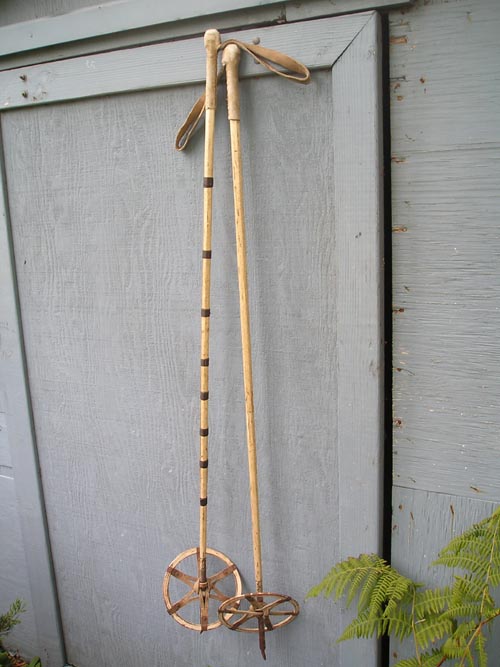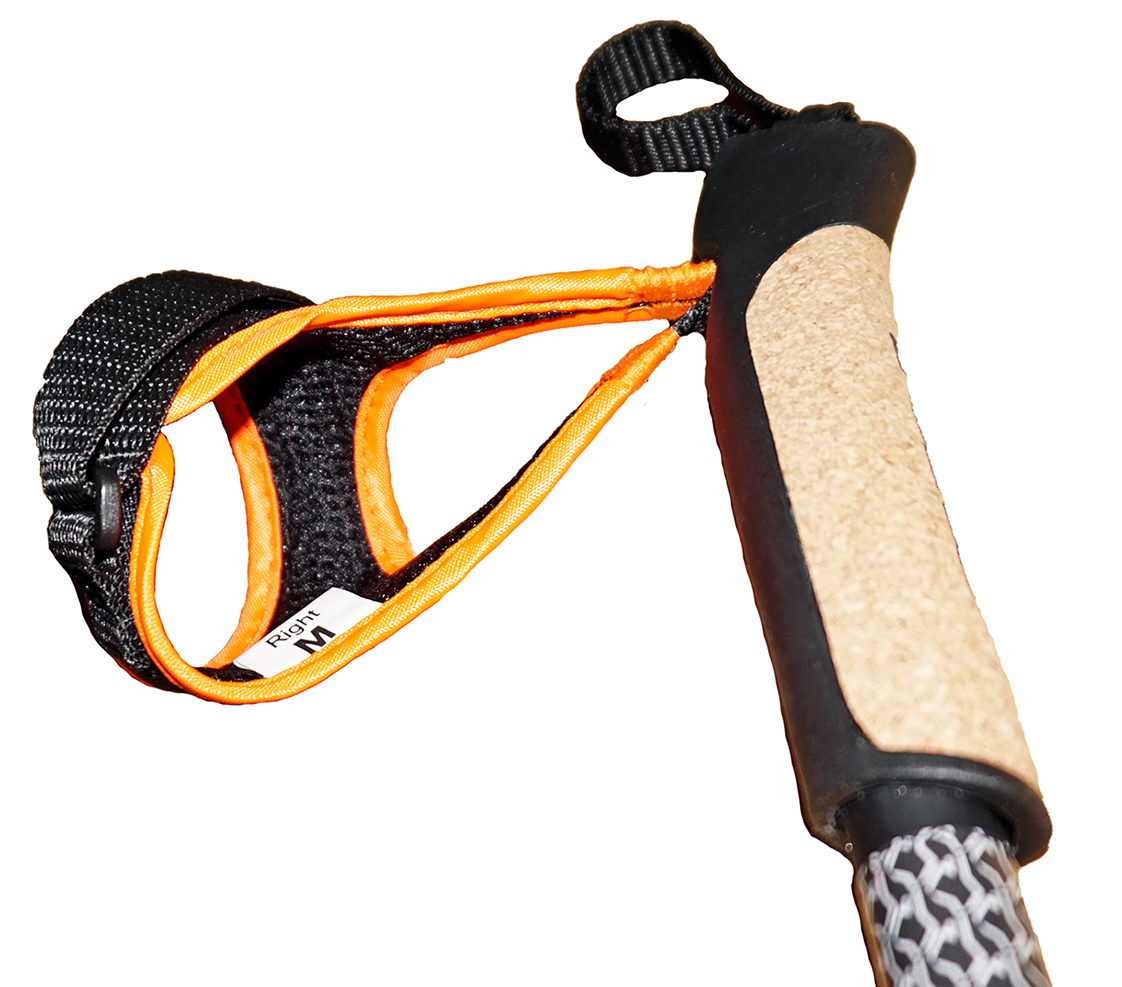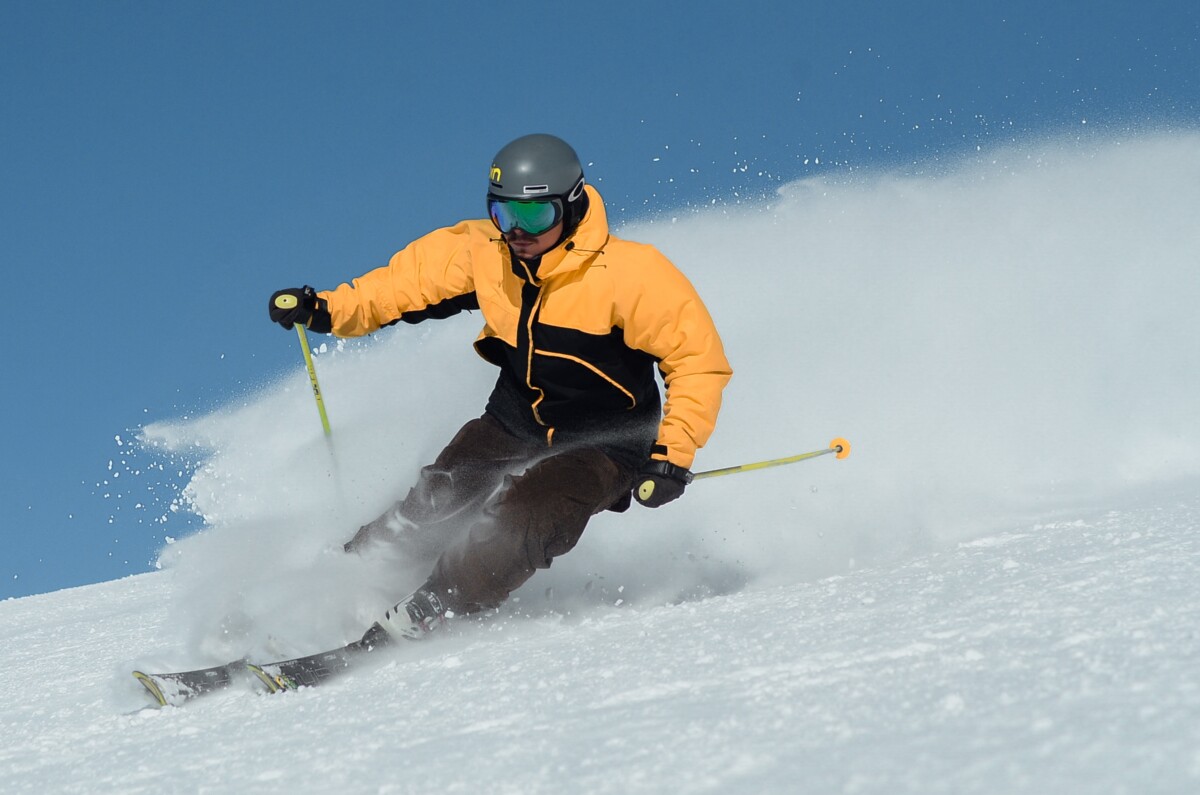Introduction
For as long as there has been evidence of people skiing, there has been evidence of skiing with ski poles. Our story begins as far back as 3623 BC, whose date corresponds to the earliest known depiction of a ski pole: a rock carving in Bøla, Norway. From its inception, ski poles have been an integral part of skiing tradition. One of the most significant milestones for young skiers is to receive their first set of poles, typically around the ages of six to nine years old. Ski poles are used to assist the skier in braking, turning, and balancing their skis. While recounting the history of ski poles, this blog aims to showcase the full history: from the traditional use of ski poles to the innovations of the 21st century.
Traditional Poles
For the vast majority of skiing’s history, skiers used only one wooden pole to assist their skiing. Unlike the competitive sport it is today, skiing was used mainly as a form of transportation in Scandinavia from the beginning of skiing to the late 19th century. Ski poles were generally made from pine or birch wood and were much heavier and wider than modern day poles. In many instances, ski poles doubled as spears used in hunting fauna near the Arctic Circle, requiring a thick, sturdy base and an edged tip to dig into the flesh of prey. Due to the bulkiness of ski poles, the use of only one pole predominated in preindustrial skiing. Skiers would grip the pole with two hands and position the bottom of the pole slightly behind their body to push off from the ground to accelerate. Skiers would use this same position to brake, dragging their poles on the ground to decrease their momentum. Ski poles were created using the resources of rural Scandinavia and were optimized for functionality and hunting, rather than for speed as in modern skiing.
Competitive Innovations
Beginning in the late 19th century and continuing into the 20th century, skiing experienced a dramatic change from being a method of transportation in rural societies to being a recreational sport for the middle to upper classes. This transformed the way in which poles were produced, distributed, and used. Prior to the industrial revolution, ski poles were generally produced in tightly knit communities near the Arctic Circle, using the native trees to construct them. The first national skiing competition in Norway occurred in 1868 and is regarded as the beginning of modern alpine skiing. Skiing’s newfound competitive nature and popularity among western upper classes caused pole production to become increasingly commercialized and international. The Madshus Ski Factory, opened in 1906, was a huge milestone in the commercialization of pole production.
As poles commercialized, they were created with materials that were lighter and more resilient as skiing transitioned into being a competitive sport. As skiing spread worldwide, ski makers looked beyond the confines of Europe and found bamboo to be an excellent material for poles, being much lighter than traditional birchwood poles while remaining durable and strong. As alpine and cross-country skiing became more competitive throughout the 20th century, poles got lighter and skinnier to maximize speed and aerodynamics. Skiers were no longer worried about spearing animals with their poles, they simply wanted to go faster.
Another major turning point in ski pole history was the transition from one pole to two. Traditionally, the bulkiness of preindustrial poles made it difficult to ski with more than one pole. However, the usage of lighter materials such as bamboo allowed skiers to use two poles without adding a significant amount of weight that could slow them down. The first documented use of two ski poles occurred in 1741, but only in the 19th century did two poles become the skiing norm, bolstered by competitive alpine skiing and enabled by lighter materials. Once weight wasn’t much of a factor, the advantages of two poles over one became glaringly clear. Two poles allowed for much more even pushes off snow that helped the skier go forward in a straight line, whereas a single pole could only be used to push off at an angle to the left or right. This also allows for nearly double the force, which translates into greater speed and momentum for the skier. These factors contributed to two poles prevailing over one as skiing became more about speed and ease of use.

The Patent Race
Throughout the 20th century, inventors raced to make patents for ski poles, testing out various materials that would give the best skiers a competitive edge. In 1933, John B. Dickson obtained the first patent for steel ski poles that also featured a detachable handle and a rubber coating. The steel backbone gave the poles a great sturdiness while the rubber exterior provided resistance to water and ice. The stretchiness of rubber allowed the poles to break free from ice coatings, whereas in a hard material ice would accumulate on the poles. The addition of rubber was a major breakthrough, and the race for new and innovative ski pole patents had begun. One important drawback to Dickson’s design was the relative heaviness of steel compared to other materials, leading to more improvements in design. In 1960, Idaho native Edward L. Scott filed a patent for a new ski pole made of aluminum alloys. Scott emphasized his lightweight invention as incredibly important for making the precise and quick turns that defined competitive alpine skiing. The lightweight and durable aluminum was incredibly popular and quickly replaced steel and bamboo poles at the top of skiing competitions, being lighter than steel and more durable than bamboo. The aluminum material was also resistant to rust that often damaged other metal poles in the cold and wet environments of skiing. The use of aluminum poles exploded in the 1960s and 70s, and they are still in widespread use today.
Aluminum poles would remain relatively unchallenged as the pole material of choice until the popularization of carbon fiber poles. Although they had existed for over a decade before his patent, David P. Goode popularized the material with his carbon fiber poles in 1990. Since his invention, aluminum, carbon fiber, and composite poles remain the most popular materials. Aluminum is generally heavier than carbon fiber, but it’s still relatively durable and is generally the cheapest option. Composite poles, made of fiberglass and resin, tend to be more flexible than aluminum, but slightly more expensive. Carbon, the most expensive option, is usually the material of choice for experts because of its flexibility and high strength to weight ratio.
Pole Diversity
Ski poles today are incredibly diverse, with different materials, lengths, costs, and features that are quite distinct. Poles used in freestyle skiing tend to be smaller and shorter for increased maneuverability while performing aerial stunts. Poles can also be adjusted for skiing on powder, which tends to favor larger baskets. The increased surface area of these baskets prevents the poles from sinking into the lighter powder snow. On the other hand, race poles have small cone-shaped baskets that maximize aerodynamics, as well as a curvature that fits neatly on the body while tucking the poles. The bend also helps the skier accelerate faster through turns.
With so many types of ski poles, it can get expensive fast for skiers who wish to ski and explore different terrains. Some ski pole manufacturers have found ways to address this problem by creating customizable ski poles. For example, in 2013, a company named CHAR poles unveiled poles whose baskets and handles could be swapped with ease. This feature allowed skiers to design their own colors and sizes that fit them the best. The customizable baskets in particular allow skiers to ski in different environments, from backcountry powder to resorts in the Rockies and Appalachian Mountains.
Manufacturing Shifts
Although traditionally confined to North America and Europe, the production of ski poles has shifted predominantly towards Asia. Out of the top ten ski pole manufacturers, six were based in China and Taiwan while the other four were located in Europe. Similar to many manufacturing jobs across the United States, much of the operations have shifted to other parts of the world where the cost of labor is cheaper. However, ski pole manufacturers in the United States still exist. One such example is the United States Ski Pole Company, based in Northern Michigan, which prides itself as the sole U.S. manufacturer of 100% carbon fiber poles. It also employs over 250 Americans in manufacturing jobs.

(Photo: Tiia Monto, Wikimedia Commons, Public Domain)
Modern Innovations
Since the introduction of aluminum to the commercial ski pole industry, there has been a pronounced decline in innovation to make ski poles lighter and slimmer. Seemingly, most of the low hanging fruit had been plucked. In the last three decades, much of ski pole innovation has shifted its focus to ensuring greater safety for skiers. For example, a recent innovation is the implementation of magnets into ski poles. Traditionally, ski poles have come with straps attached to the grips of the pole, which allow the pole to stay connected to the skier’s hand at all times. This prevents the poles from flying out of sight because of a loose grip or a rough fall. However, this may also result in wrist injuries because the pole strap is stuck to a skier’s wrist. If the pole gets caught on a branch or a hard patch of snow, the skier’s wrist will be yanked alongside it. To address this, in 2019 the company Magfit released a new ski pole fitted with a boron, iron, and neodymium alloy magnet attached to the top of the grip. The poles come with specially designed straps that can be fitted to the skier’s glove and attach to the magnet on the grip. While a person is skiing, the magnets hold on tight, so the poles don’t fly away. In case of a fall, enough pressure will release the magnets, allowing the poles to become untethered without injuring the skier’s wrist. This innovative design is one solution to reducing the risk of injury in skiing while still providing the benefits of ski pole straps.
Another company, Leki, based in Quebec, has patented the Leki Trigger S System, which has a similar goal to the new magnetic poles. However, instead of utilizing magnets, Leki S poles come with gloves that have a very small strap located between the thumb and index finger portion of the gloves. By attaching the strap at the hand, the risk of a wrist injury is reduced significantly. A strong tensile load initiated by a rough fall will release the strap, avoiding any injury due to the pull of the poles.
Conclusion
Ski poles have come an incredibly long way since the first skiers used them to travel and hunt. A 2005 study by Formenti et. al found that the total weight of a sample of skis, bindings, boots and poles decreased from 5.0 kg in 542 AD to 2.6 kg in 1970 to 2.0 kg in 2004, while the number of poles increased from one to two during those years. Throughout the same period, the average width decreased from 149 mm to 43 mm and the material changed from pine to carbon fiber. As a result, the metabolic cost of the equipment decreased from 4.285 J/(kg*m) to 1.917 J/(kg*m). Spurred on by the rise of competitive skiing, the weight and size of ski poles decreased dramatically, allowing for more efficient and therefore faster skiers. As the commercialization of skiing became widespread, ski pole innovation eventually shifted its focus to ensuring the safety of skiers, including amateur ones who may be prone to frequent falls. The manufacturing industry changed as well, with production moving from Europe and the U.S. to being primarily based in Asia. As a whole, ski poles have changed dramatically across the centuries, and will continue to do so as innovation drives pole technology forward.
Bibliography
“5 Takeaways from Touring the World’s Oldest Ski Factory.” Team USA, Accessed April 22, 2022, https://www.teamusa.org/News/2016/February/18/5-Takeaways-From-Touring-The-Worlds-Oldest-Ski-Factory.
“About Us.” United States Ski Pole Company, 8 Dec. 2021, https://usskipoles.com/about-us/.
Allen, E. John B. The Culture and Sport of Skiing: From Antiquity to World War l. Amherst: University of Massachusetts Press, 2007.
“Alpine Skiing – News, Athletes, Highlights & More.” Olympics.com, Accessed April 22, 2022, https://olympics.com/en/sports/alpine-skiing/.
Azer, Robin. “Scott Poles: Iconic through the Years.” SnowBrains, 8 May 2018, https://snowbrains.com/scott-poles-iconic-years/.
Benson, Jack A. “Before Skiing Was Fun.” Western Historical Quarterly 8, no. 4 (1977), 41–413.
“Carbon-Fiber Forefather Dave Goode Passes Away.” Backcountry Magazine, 20 Jan. 2020, https://backcountrymagazine.com/stories/carbon-fiber-forefather-dave-goode-passes-away/.
Eimeleus, K. B. E. E., et al. Skis in the Art of War. Ithaca: Cornell University Press, 2019.
Formenti, Federico, et al. “Human Locomotion on Snow: Determinants of Economy and Speed of Skiing across the Ages.” Proceedings. Biological Sciences, The Royal Society, 7 Aug. 2005, https://www.ncbi.nlm.nih.gov/pmc/articles/PMC1559840/.
“Gamekeeper’s Thumb On The Ski Slopes.” The British Medical Journal 1, no. 5901 (1974), 14-213.
“Leki Trigger S System: Leki Innovations.” Leki Canada, 14 Oct. 2020, https://www.leki.ca/en/about-leki/innovations/trigger-s/.
“Magnetic Ski Poles.” Magfit, Accessed May 2, 2022, https://www.magfit.cloud/en/magnetic-ski-poles/.
Snapp, Conner. “Char Poles’ Unique Design Revolutionizes Ski Industry Worldwide.” CHAR Poles’ Unique Design Revolutionizes Ski Industry Worldwide, 30 June 2018, https://www.prnewswire.com/news-releases/char-poles-unique-design-revolutionizes-ski-industry-worldwide-237014381.html.
SkiingLab, Team, and Team SkiingLab. “Carbon vs. Aluminum Ski Poles.” SkiingLab, 30 Dec. 2021, https://skiinglab.com/carbon-vs-aluminum-ski-poles/.
“Ski Pole Buying Guide.” Skis.com, Accessed May 2, 2022, https://www.skis.com/pages/ski-pole-buying-guide.
“The Kids Ski Pole Ultimate Guide.” Skiing Kids, 25 Feb. 2022, https://skiingkids.com/ski-poles-for-kids-best-ski-poles/.
“US1961099A – Ski Pole Grip and Ring.” Google Patents, Google, Accessed April 22, 2022, https://patents.google.com/patent/US1961099.
“US3076663A – Ski Pole Construction.” Google Patents, Google, Accessed April 22, 2022, https://patents.google.com/patent/US3076663.

